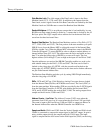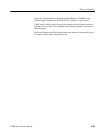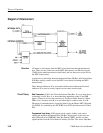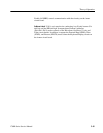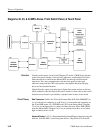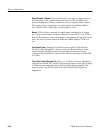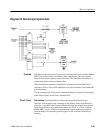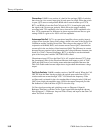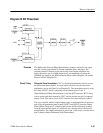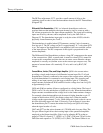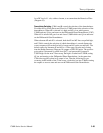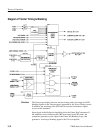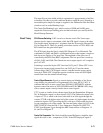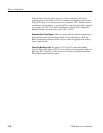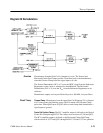
Theory of Operation
3–66
1780R-Series Service Manual
Chroma Amp. U486D is one section of a dual-in-line package (DIP) of switches
that closes on a low control input (pin 16) and opens on a high. When the switch
is open, Q573 turns on and parallels R566 with a network made up of C570,
R571, and R568 to lower the Gain Cell gain by 25%. Lowering the gain scales
the signal to the Vectorscope graticule, which allows the targets normally
associated with 75% amplitude color bars to be used for 100% amplitude color
bars. C570 compensates for difference in phase response between the two gain
settings. R568 is a gain set for 100% color bar amplitude.
Vectorscope Gain Cell. U473 is an operational amplifier whose positive input is
voltage driven from the Vector Gain voltage, which is the sum of the Vector Gain
Calibration and the Variable Vector Gain. The voltage at the output of U473, in
conjunction with R469, R470, and constant current source Q467, determine the
current split in the two halves of dual-transistor Q468. The difference in current
between the two transistor halves determines the voltage difference between pins
8 and 10 of U467. Chroma Gain Range, R572, is adjusted to set the minimum
gain of the front-panel variable VECTOR GAIN control.
Chrominance input (J574) to the Gain Cell is AC-coupled chroma (C573) from
the chrominance filter (in the Waveform Monitor) that inputs to pin 4 of U467.
Q459 and Q462 form a level setting transconductance amplifier that turns the
Gain Cell double-ended current output into a single-ended chrominance voltage
output.
Test Circle Oscillator. U486B is another section of the DIP switch. When the CAL
OSC EN from the Data Latch goes high, the switch opens and allows Q291 to
conduct and draw current through Y195. Y195 dictates the frequency of the
oscillator and is selected for the color standard that is being decoded. Q186 and
Q187 form a high gain amplifier stage. Q290 is the output clamp and provides
the feedback to control the bias of Q291 to close the loop.
Cal Osc signal processing and switching occurs on Diagram 4 (Input &
Reference Selection), with the Cal Osc signal routed back through the chroma
filter (Diagram 5 – Difference Amp and Video Filters) and input to the Gain Cell
when Test Circle is selected.



